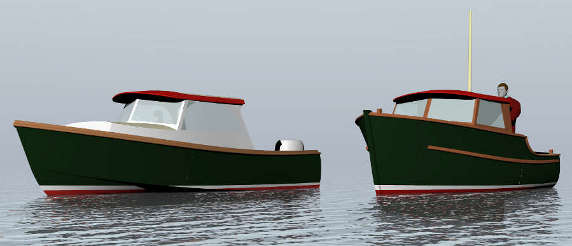Oak 18' Inshore Fisherman
 Oak 18' Inshore Fisherman
Oak 18' Inshore Fisherman  Oak 18' Inshore Fisherman
Oak 18' Inshore Fisherman  Oak 18' Inshore Fisherman
Oak 18' Inshore Fisherman  Oak 18' Inshore Fisherman
Oak 18' Inshore Fisherman  Oak 18' Inshore Fisherman
Oak 18' Inshore Fisherman  20' Berry Point Outboard Cruiser with Oak 18 Inshore Fisherman
20' Berry Point Outboard Cruiser with Oak 18 Inshore Fisherman 20' Berry Point Outboard Cruiser with Oak 18 Inshore Fisherman
20' Berry Point Outboard Cruiser with Oak 18 Inshore Fisherman 20' Berry Point Outboard Cruiser with Oak 18 Inshore Fisherman
20' Berry Point Outboard Cruiser with Oak 18 Inshore Fisherman 20' Berry Point Outboard Cruiser with Oak 18 Inshore Fisherman
20' Berry Point Outboard Cruiser with Oak 18 Inshore Fisherman
Similar Designs
About the Plans
Construction Method and Materials:
Oak was originally intended for cold-molded construction but currently almost everyone has replaced that method with sheathed strip planking. This is usually done over permanent plywood bulkheads which are then fillet and taped to the inside of the planking. Stem, keel, and clamp are laminated members. I supply full size patterns for the stem, transom, and bulkheads so little lofting required.Number and Type of Drawings:
Lines and offsets, General Construction, Construction sections, Stern Gear, General Arrangement, and full size patterns. Drawings are hand done and all measurements are in Imperial units.Price:
Design Comments

20' Berry Point Outboard Cruiser with Oak 18 Inshore Fisherman.
Oak 18 Inshore Fisherman, as well as the small boats Alder 18, Douglasfir28, Sitka Spruce, and Ironbark 28, is one of ten power boat designs Tad created for his article “Power Boat Design, Form and Function” published in Wooden Boat #137. Read the PDF version.
Oak is an 18 foot semi-displacement boat, styled after the type known in the British Iles as Inshore Fisherman.
The engine for Oak is the same as that of Yellow Cedar, the 28 HP Perkins, but with 1.4:1 reduction gears. With this power Oak will run up to a speed/length (S/L) of 2.2 or FNV of 1.37, which is 9 knots. She is faster than Alder even though she's heavier mostly because of a increase in her power/weight ratio. Alder has one HP for every 350 lbs of boat, while Oak has one HP for every 135 lbs of boat, two and a half times the power!
There are also subtle changes in hullform for the faster boat. Look at Oak's curve of areas and compare it to that of Alder. You can see Oak is much fuller aft and her LCB is at station 5.65, whereas that of Alder is at station 5.4 . Again we come to looking at sterns, note Oak's transom immersion. For her S/L of 2.2 the immersed section area at the transom needs to be about 45% of the area of station six. These broad quarters keep the stern up as she gets going and leaves the stern wave behind.
With increased freeboard, speed, and reserve power, Oak has considerable more capacity than Alder...For the fisherman, more speed means more spots can be tried each day. As a pleasure boat, Oak can maintain her speed in adverse weather, so you can get home even when the wind blows.
